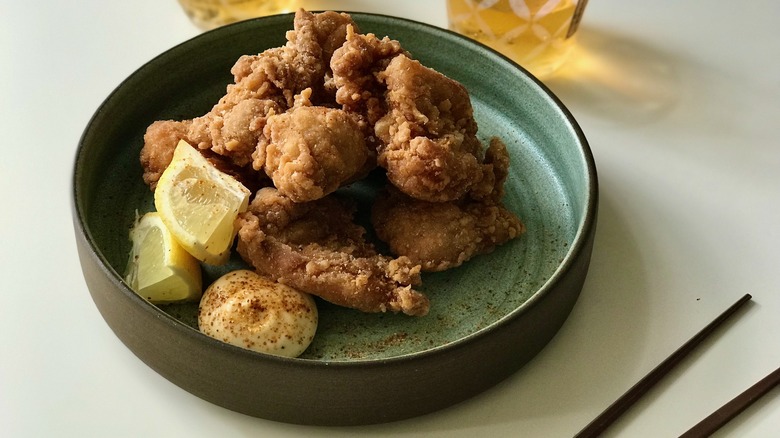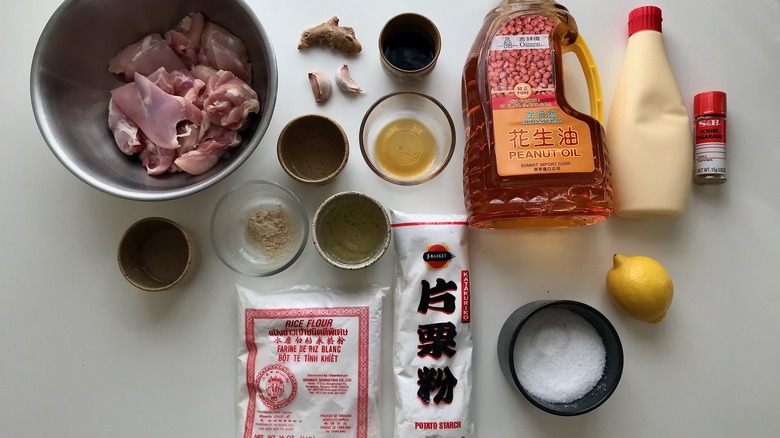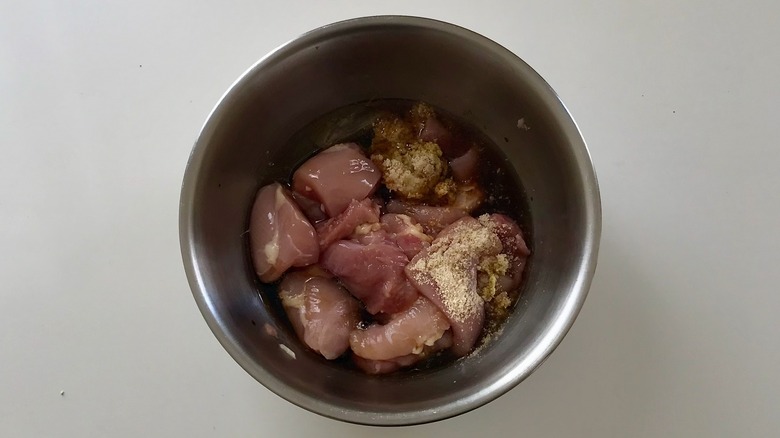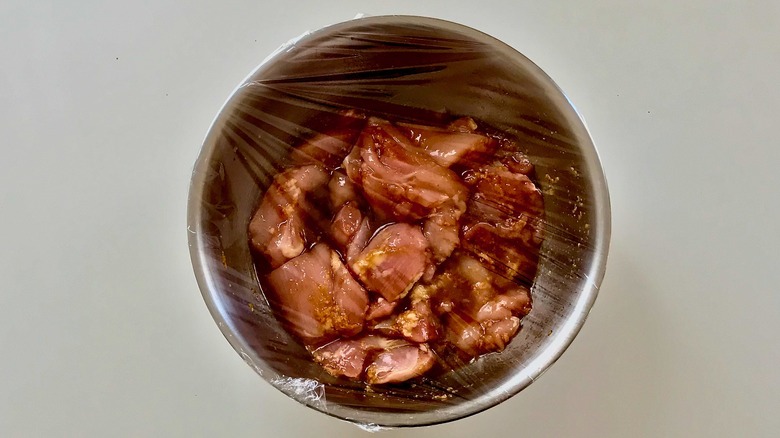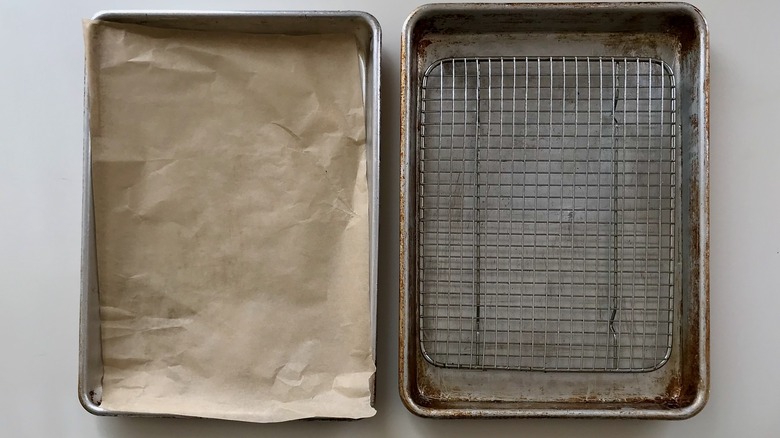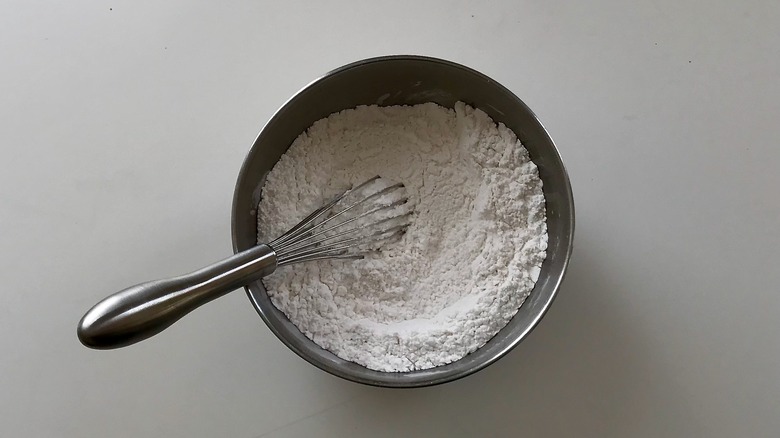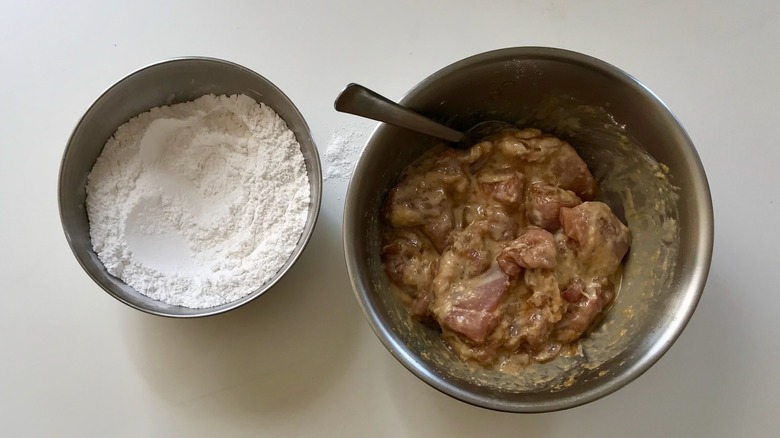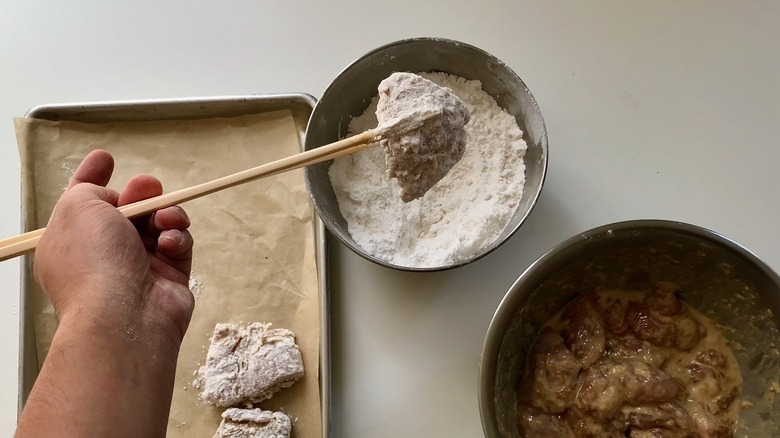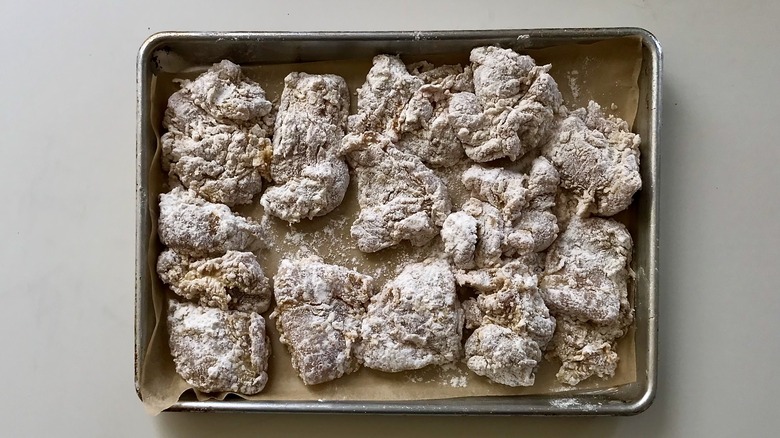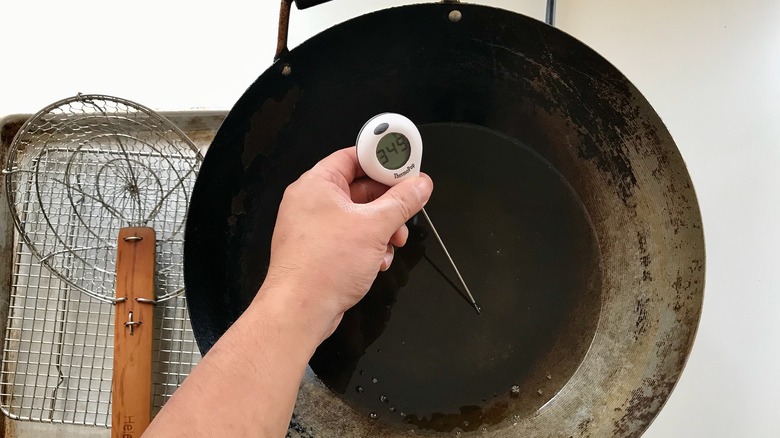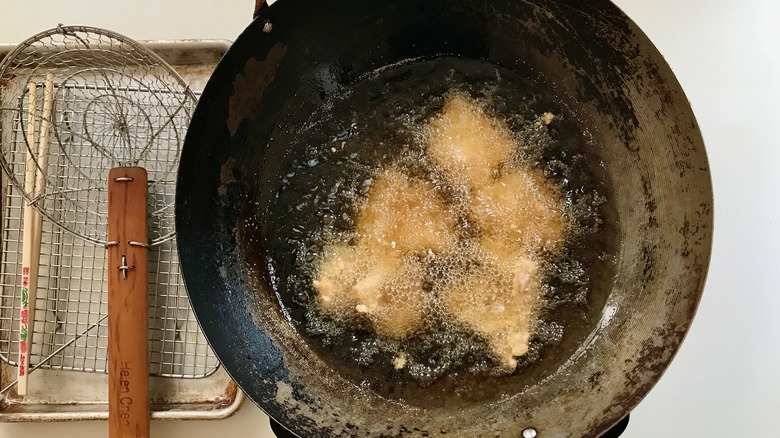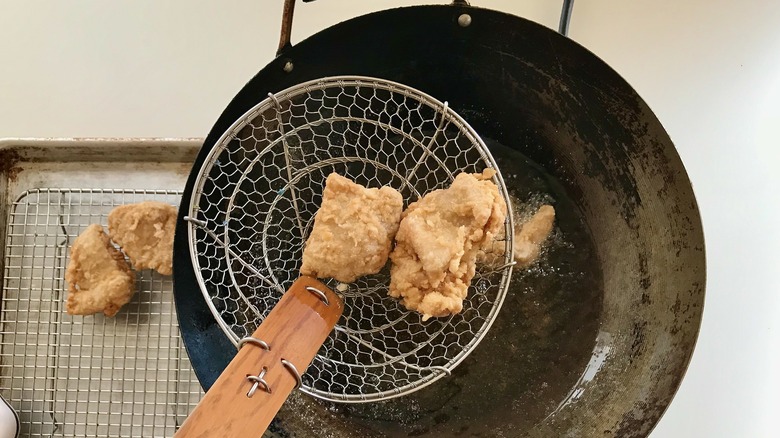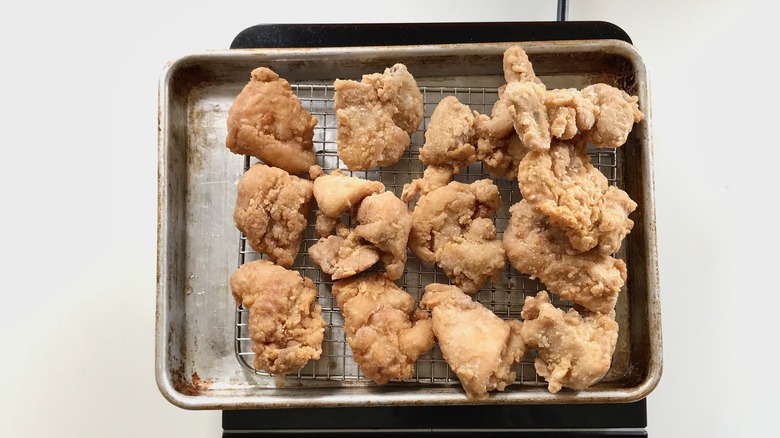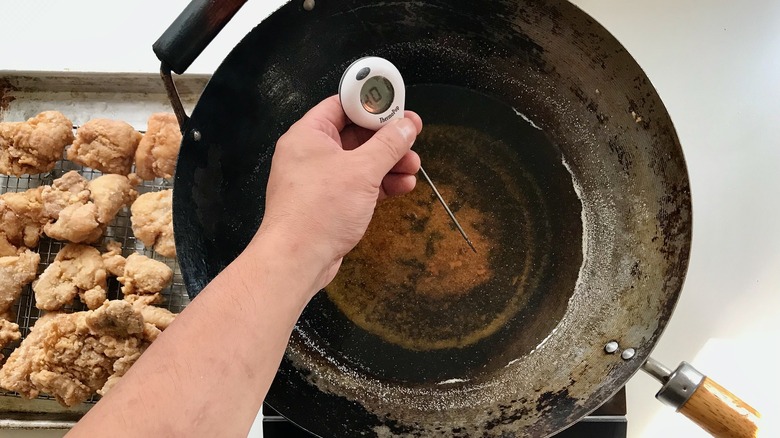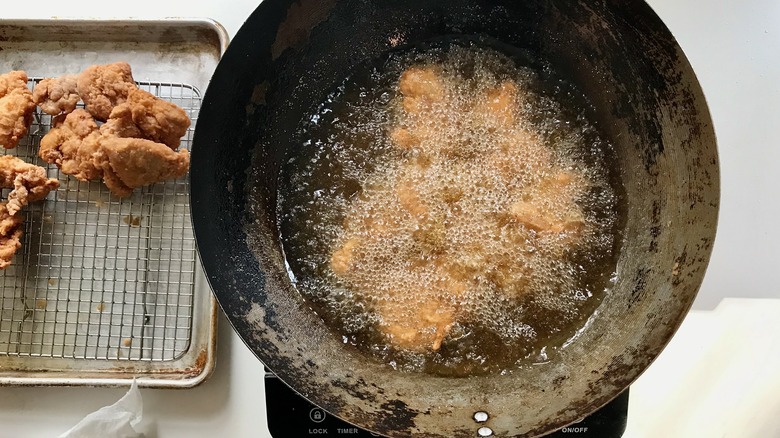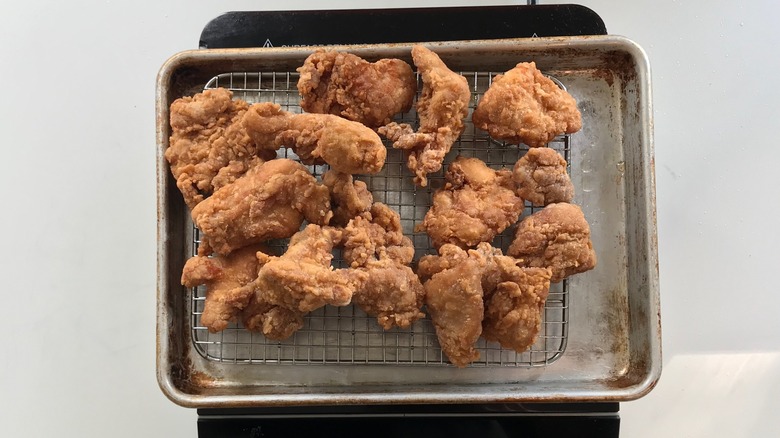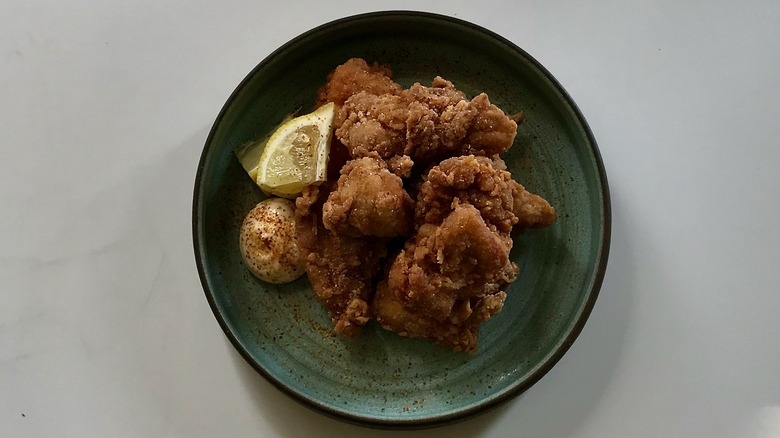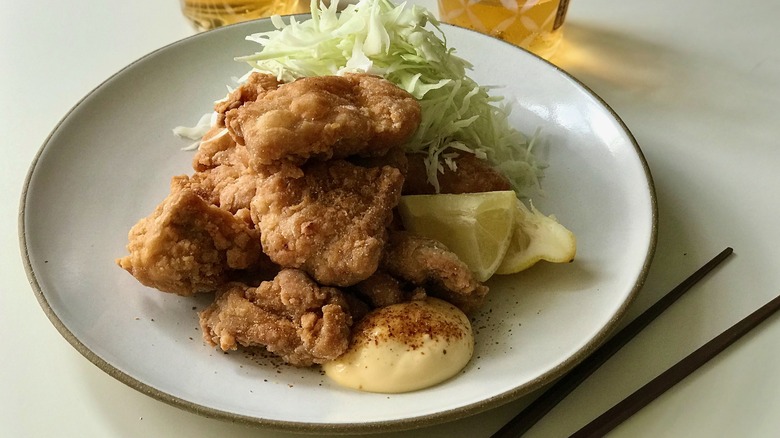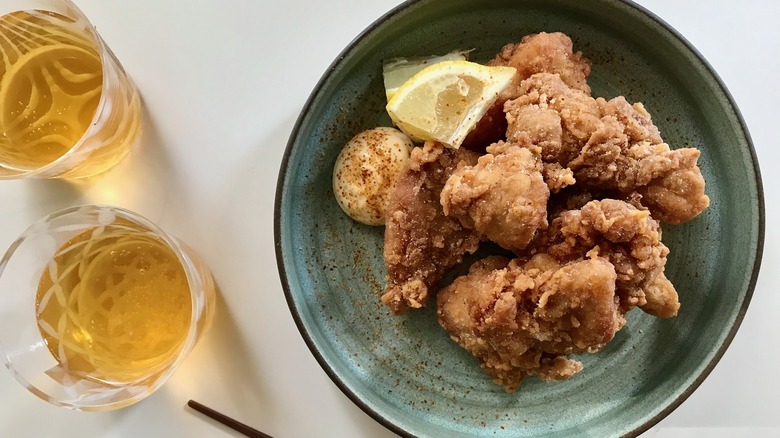Double-Fried Karaage Chicken Recipe
Bite-sized karaage, as recipe developer Kevin Chen tells us, is "one of my favorite forms of fried chicken." While the dish can be found in bars and restaurants throughout Japan, Chen notes that "it's just as commonly seen in home cooking, often packed into a bento for the next day's lunch." This should tell you something about the relative ease of making this chicken, which Chen calls perfectly straightforward, especially if you're familiar with frying.
"Karaage, at least in Japan, isn't necessarily always chasing that ultra crispy and crunchy texture the way American fried chicken tends to," he explains. "The crust often has a softer crunch, with a lightness that's wonderful paired with the juicy and umami interiors." In this recipe, Chen marries the two styles of fried chicken, double-frying the chicken for that extra crunch loved by Americans while still retaining the lightness of the Japanese variety. He also points out that the potato starch and rice flour batter he uses is gluten-free, which means that the entire dish can be as well, if you substitute tamari for soy sauce.
Collect the ingredients to make double-fried karaage chicken
Chen makes his karaage chicken with boneless, skinless thighs. These are marinated in soy sauce, sake, vodka, ginger, garlic, powdered chicken bouillon, and sesame oil for flavoring, then coated in a batter of egg white, rice flour, and potato starch. The only other ingredients you'll need are a fair amount of cooking oil for deep frying and some salt for seasoning. And if you'd like to serve Chen's optional accompaniments on the side, those include Kewpie mayonnaise, lemon wedges, and shichimi togarashi.
Step 1: Mix up the marinade
In a medium bowl, combine chicken, soy sauce, sake, vodka, ginger, garlic, chicken powder, sesame oil, and egg white.
Step 2: Marinate the chicken
Mix until chicken is evenly coated in the marinade, cover, and refrigerate for at least 30 minutes or up to 24 hours.
Step 3: Prepare some sheet trays
Line a rimmed baking sheet with parchment paper. Place a wire rack over a second rimmed baking sheet.
Step 4: Combine the flour and starch
In a medium bowl, whisk together the rice flour and potato starch.
Step 5: Batter the chicken
Add 2 tablespoons of the flour mixture to the marinated chicken and mix until chicken is coated in a thin batter.
Step 6: Coat a piece in flour
Add 1 piece of chicken at a time to flour mixture and turn to coat, making sure all the crevices are coated.
Step 7: Finish coating all the chicken
Shake excess flour off chicken and transfer to the parchment-lined baking sheet. Repeat with the remaining chicken.
Step 8: Heat up the cooking oil
In a wok or large Dutch oven, heat oil to 350 F.
Step 9: Begin frying the chicken
Add chicken to oil 4-5 pieces at a time, adjusting heat as necessary to maintain an oil temperature between 300-325 F.
Step 10: Continue frying the chicken
Fry until chicken is light golden brown and just cooked through, about 3-4 minutes. Using a spider, transfer fried chicken to the wire rack.
Step 11: Finish frying, then cool the chicken
Repeat with the remaining chicken and allow the meat to cool for 5 minutes.
Step 12: Make the oil even hotter
Increase oil temperature to 400 F.
Step 13: Re-fry the chicken
Fry chicken a second time, 4-5 pieces at a time, until crisp and deeply golden brown, about 1 minute.
Step 14: Salt the chicken as soon as it's finished frying
Using a spider, transfer the chicken back to the wire rack. Season immediately with salt to taste. Repeat with the remaining chicken pieces.
Step 15: Eat the chicken plain or with your preferred condiments
Serve chicken right away with lemon wedges, Kewpie mayonnaise, and shichimi togarashi, if desired.
What ingredient substitutions can I make in this double-fried karaage chicken recipe?
Even though this recipe is a relatively simple one, there are still some substitutions you can make if need be. For one thing, Chen tells us that chicken breasts can be used in place of thighs if you prefer, but "bear in mind that they will be slightly drier because there's less fat." Fortunately, he adds, "The soy sauce in the marinade acts as a brine, so it will help prevent the chicken from drying out too much."
Chen also says that while potato starch is traditionally used for karaage batter in Japan and results in a "slightly crispier and lighter texture," cornstarch makes a perfectly good substitute. As for the alcohol in the batter, Chen explains that the vodka "cooks off more rapidly than water, thereby delivering a slightly crispier crust." Sake is used for flavoring and could be replaced with similarly acidic white wine, but you're free to omit either or both boozy ingredients.
How should I serve double-fried karaage chicken?
As Chen sees it, karaage chicken "makes a good appetizer for a party or a main course for an izakaya-style meal." Izakaya food is basically the Japanese answer to bar appetizers, although consuming it with booze is, of course, optional. If you'd like to make a whole spread of izakaya dishes, Chen recommends agedashi tofu, blistered shishito peppers, and Japanese potato salad to pair with the chicken.
While Chen prefers to enjoy his kaarage with the classic accompaniments of lemon wedges, shichimi togarashi, and Kewpie mayonnaise, he says, "You could certainly get creative and spike the mayo with whatever flavors you want." One of his favorite ways to do so, he tells us, is to stir in some yuzu kosho, or Japanese citrus chili paste. This addition, he says, adds "brightness, heat, and umami" to a condiment that can be quite mild on its own.
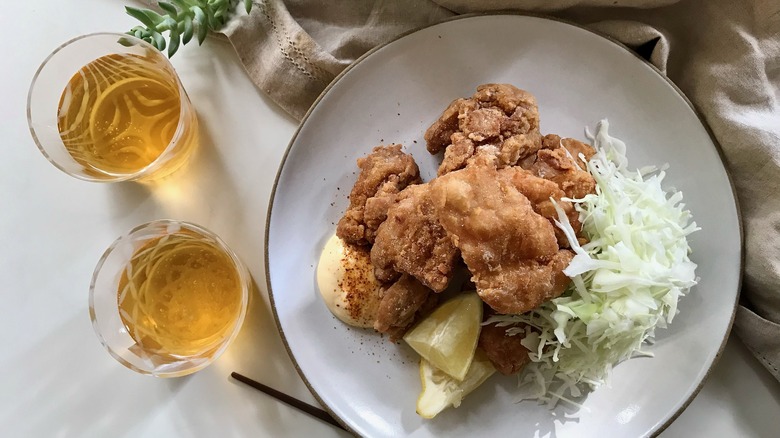
- 1 pound boneless chicken thighs, cut into 2-inch pieces
- 2 tablespoons soy sauce
- 1 tablespoon sake
- 1 tablespoon vodka
- 1 tablespoon finely grated fresh ginger
- 2 large garlic cloves, finely grated
- 1 teaspoon chicken powder
- ½ teaspoon toasted sesame oil
- 1 large egg white
- ½ cup rice flour
- ¼ cup potato starch
- 1 quart oil (such as peanut, rice bran, or canola), for frying
- Salt, to taste
- Lemon wedges, for serving
- Kewpie mayonnaise, for serving
- Shichimi togarashi, for serving
- In a medium bowl, combine chicken, soy sauce, sake, vodka, ginger, garlic, chicken powder, sesame oil, and egg white.
- Mix until chicken is evenly coated in the marinade, cover, and refrigerate for at least 30 minutes or up to 24 hours.
- Line a rimmed baking sheet with parchment paper. Place a wire rack over a second rimmed baking sheet.
- In a medium bowl, whisk together the rice flour and potato starch.
- Add 2 tablespoons flour mixture to the marinated chicken and mix until chicken is coated in a thin batter.
- Add 1 piece of chicken at a time to flour mixture and turn to coat, making sure all the crevices are coated.
- Shake excess flour off chicken and transfer to the parchment-lined baking sheet. Repeat with the remaining chicken.
- In a wok or large Dutch oven, heat oil to 350 F.
- Add chicken to oil 4-5 pieces at a time, adjusting heat as necessary to maintain an oil temperature between 300-325 F.
- Fry until chicken is light golden brown and just cooked through, about 3-4 minutes. Using a spider, transfer fried chicken to the wire rack.
- Repeat with the remaining chicken and allow the meat to cool for 5 minutes.
- Increase oil temperature to 400 F.
- Fry chicken a second time, 4-5 pieces at a time, until crisp and deeply golden brown, about 1 minute.
- Using a spider, transfer the chicken back to the wire rack. Season immediately with salt to taste. Repeat with the remaining chicken pieces.
- Serve chicken right away with lemon wedges, Kewpie mayonnaise, and shichimi togarashi, if desired.
| Calories per Serving | 614 |
| Total Fat | 45.6 g |
| Saturated Fat | 7.2 g |
| Trans Fat | 0.2 g |
| Cholesterol | 111.7 mg |
| Total Carbohydrates | 25.1 g |
| Dietary Fiber | 0.7 g |
| Total Sugars | 0.2 g |
| Sodium | 546.7 mg |
| Protein | 21.8 g |

